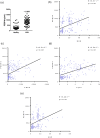Diagnostic value of phosphatidylethanolamine binding protein 4 levels in patients receiving nursing interventions for advanced chronic kidney disease
- PMID: 33752499
- PMCID: PMC7995466
- DOI: 10.1177/0300060521996179
Diagnostic value of phosphatidylethanolamine binding protein 4 levels in patients receiving nursing interventions for advanced chronic kidney disease
Abstract
Objective: To explore the diagnostic role of phosphatidylethanolamine binding protein 4 (PEBP4) in patients with chronic kidney disease (CKD) receiving nursing interventions.
Methods: ELISA was used to evaluate serum PEBP4 levels. Receiver-operating characteristic curve analysis was used to assess diagnostic accuracy. Spearman correlation analysis was used to assess the relationships between PEBP4 levels and biochemical indexes.
Results: Serum PEBP4 was high in CKD patients compared with healthy individuals. PEBP4 levels were positively correlated with pathological stage in CKD patients. PEBP4 had higher sensitivity for diagnosis of CKD than common indexes including blood urea nitrogen, creatinine and C-reactive protein. Among CKD patients treated with calcium channel blockers, serum PEBP4 levels declined notably and were associated with concentrations of K+, Na+, Cl- and Ca2+. Nursing interventions significantly decreased serum PEBP4 levels. A significant association between serum PEBP4 level and ionic concentration was observed in CKD patients receiving nursing interventions.
Conclusions: This prospective study demonstrated that PEBP4 level might represent an effective diagnostic biomarker in CKD patients. PEBP4 also acted as a valuable care compliance factor for determining the necessity for nursing interventions. Nursing interventions restored ion channel function and subsequently resulted in decreased PEBP4 levels and proteinuria.
Keywords: Advanced chronic kidney disease; care compliance; diagnostic biomarker; ion channel; nursing care; phosphatidylethanolamine binding protein 4.
Conflict of interest statement
Figures





Similar articles
-
Overexpression of phosphatidylethanolamine-binding protein 4 (PEBP4) associates with recurrence of meningiomas.Clin Neurol Neurosurg. 2022 Mar;214:107148. doi: 10.1016/j.clineuro.2022.107148. Epub 2022 Jan 29. Clin Neurol Neurosurg. 2022. PMID: 35158167
-
Phosphatidylethanolamine binding protein-4 (PEBP4) is increased in IgA nephropathy and is associated with IgA-positive B-cells in affected kidneys.J Autoimmun. 2019 Dec;105:102309. doi: 10.1016/j.jaut.2019.102309. Epub 2019 Aug 9. J Autoimmun. 2019. PMID: 31402200
-
Increased expression of phosphatidylethanolamine-binding protein 4 (PEBP4) strongly associates with human gliomas grade.J Neurooncol. 2016 Apr;127(2):235-42. doi: 10.1007/s11060-015-2040-6. Epub 2016 Jan 2. J Neurooncol. 2016. PMID: 26725095
-
Study on the relationship between lipoprotein (a) and diabetic kidney disease.J Diabetes Complications. 2023 Jan;37(1):108378. doi: 10.1016/j.jdiacomp.2022.108378. Epub 2022 Dec 15. J Diabetes Complications. 2023. PMID: 36549039 Review.
-
Diagnostic accuracy of serum cystatin C in chronic kidney disease: a meta-analysis.Clin Nephrol. 2015 Aug;84(2):86-94. doi: 10.5414/cn108525. Clin Nephrol. 2015. PMID: 26200185 Review.
Cited by
-
The Rho kinase signaling pathway participates in tubular mitochondrial oxidative injury and apoptosis in uric acid nephropathy.J Int Med Res. 2021 Jun;49(6):3000605211021752. doi: 10.1177/03000605211021752. J Int Med Res. 2021. PMID: 34167354 Free PMC article.
-
Modern Biomarkers in IgA Nephropathy and Their Potential in Paediatric Research.J Clin Med. 2025 May 7;14(9):3263. doi: 10.3390/jcm14093263. J Clin Med. 2025. PMID: 40364294 Free PMC article. Review.
-
PEBP4 Directs the Malignant Behavior of Hepatocellular Carcinoma Cells via Regulating mTORC1 and mTORC2.Int J Mol Sci. 2022 Aug 8;23(15):8798. doi: 10.3390/ijms23158798. Int J Mol Sci. 2022. PMID: 35955931 Free PMC article.
-
PEBP4 deficiency aggravates LPS-induced acute lung injury and alveolar fluid clearance impairment via modulating PI3K/AKT signaling pathway.Cell Mol Life Sci. 2024 Mar 13;81(1):133. doi: 10.1007/s00018-024-05168-5. Cell Mol Life Sci. 2024. PMID: 38472560 Free PMC article.
References
-
- Eknoyan G, Levin NW. K/DOQI clinical practice guidelines for chronic kidney disease: Evaluation, classification, and stratification. Am J Kidney Dis 2002; 39: S14–S266. DOI: 10.1053/ajkd.2002.30939. - PubMed
-
- Webster AC, Nagler EV, Morton RL, et al.. Chronic kidney disease. Lancet 2017; 389: 1238–1252. DOI: 10.1016/s0140-6736(16)32064-5. - PubMed
-
- Lamb EJ, Levey AS, Stevens PE. The Kidney Disease Improving Global Outcomes (KDIGO) guideline update for chronic kidney disease: Evolution not revolution. Clin Chem 2013; 59: 462–465. DOI: 10.1373/clinchem.2012.184259. - PubMed
MeSH terms
Substances
LinkOut - more resources
Full Text Sources
Other Literature Sources
Medical
Molecular Biology Databases
Research Materials
Miscellaneous

